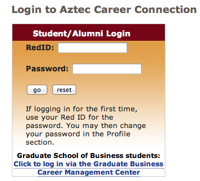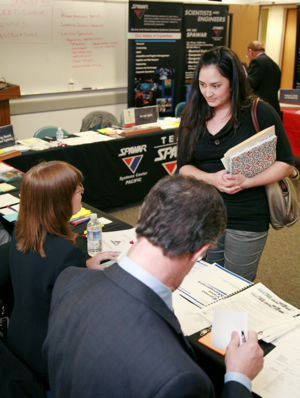Aztec Career Connection

Whichever option is best for you, the Aztec Career Connection website is a great starting point for your job search.
Exclusively available to SDSU students and alumni, the site includes hundreds of current job openings (both on and off campus) that you can apply for in minutes with your stored resume and cover letter. Unlike other popular job-hunting sites, employers are pre-screened by Career Services staff to protect you from fraudulent postings.
What’s more, many potential employers are Aztec alumni looking to give back to the university by hiring current students and fellow alumni.
Degree vs. work experience
Along with the security of a regular paycheck, students who choose to work are also getting ahead of the post-graduation job search frenzy by beefing up their resume with more than just their newly earned college degree.
“A degree is extremely valuable, but employers also value work experience and a transferable skill set,” Nieves said. “Finding positions that relate to their academic field of study can really help students stand out in a large pool of applicants.”
Bobbie Gray, a Career Services counselor, added that by junior year, students should be pursuing work experience in the same field they are planning to enter after graduation.
Work and school: The right balance
Once you’ve found the right position, nailed the interview and landed the job, the real work now begins. Striking a manageable balance between work and school that allows you to excel in both pursuits isn’t always an easy task, but it is possible.
U.S. News and World Report recently highlighted research indicating that the most successful students are the ones who cap their workweek at 15 hours.
Nieves agreed, saying that students working more than 20 hours per week may find it more difficult to manage their time and responsibilities, ultimately losing focus of academic priorities.
Employers posting to the Career Connection site are encouraged to offer 15-20 hour workweeks to support students’ ability to find a healthy equilibrium between the demands of college life and work demands.

If you’re wondering where you could possibly fit another 15 hours into your jam-packed schedule every week, you’re not alone. Gray said she sees many students who feel like they have no extra time for work or internships during the semester. Her advice? Make some adjustments — even sacrifices — to ensure you don’t miss out on an opportunity to better prepare yourself for your desired career path.
“You’re human! You need time for rest and settling your brain, but you also need experience outside of the classroom,” Gray said. “Plan ahead by writing down all your commitments and start to estimate the time needed to follow through with your goals. I like to tell students ‘Plan your work and work your plan’.”
If a gap between expenses and income is threatening to throw off this delicate balance, contact the Office of Financial Aid and Scholarships to make sure you’re taking advantage of all possible resources for covering costs during the semester.

